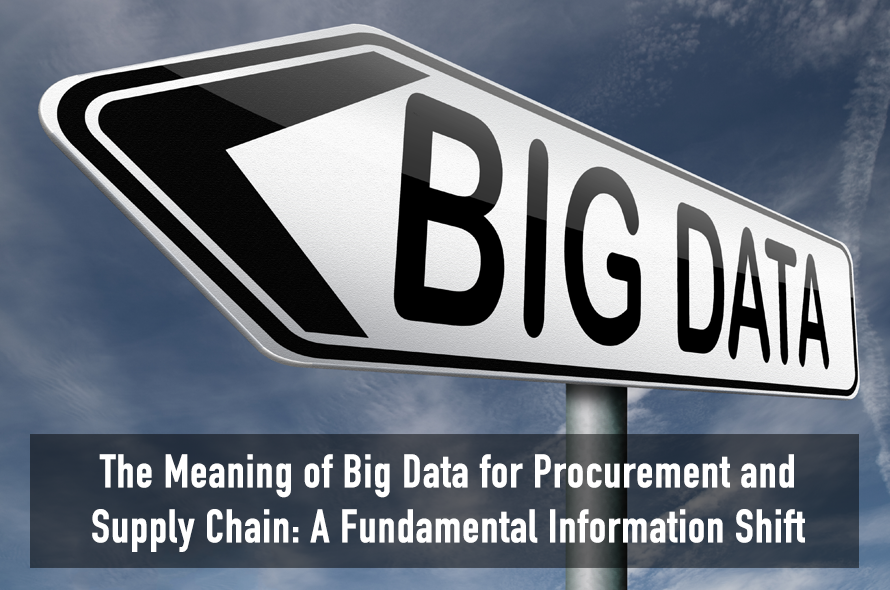Introduction
"Big Data" is going to make an impact on creating new types of applications, information services and improving existing applications. In this special report, Spend Matters PRO sheds some light on Big Data and what it means for procurement and the supply chain. Change is coming and big data is driving it — find out what’s next in this special report.
Spend Matters PRO readers are likely to be at least familiar on a cursory level with the term “Big Data.” Big Data has come to mean different things to different people (and groups) within companies. For IT organizations, Big Data often represents the confluence of different sources of internal systems information needed to make better and more rapid business decisions. But most important, for IT, Big Data, at least as they see it, is a technology problem that IT deserves the first crack at getting their arms around – and owning.
For line of business users in procurement, HR, sales and other areas, the concept of Big Data is a bit more varied – and in certain cases, nebulous. Some have been pitched solutions to handle their Big Data “problem” as if they had one they even knew about! Others have certainly taken note of the increasing array of datasets they can incorporate into decision-making, even if they haven’t studied up on the term or listened to vendors hawking their wares (not to mention services providers conjuring up scenarios of the bucolic insight afterlife that Big Data nirvana brings).
Alas, in all of the land grabs, hyperbole, and sales/marketing hype surrounding the concept of Big Data, procurement and supply chain organizations have largely been left to fend for themselves to make sense of it all. Fortunately (or not, depending on one’s perspective) Big Data hasn’t been on the tip of the tongue for many influencers and providers educating procurement organizations on how best to tackle their information needs. Rather, procurement and supply chain organizations continue to hear familiar refrains of how to build better spend analysis approaches, speed up existing processes such as sales and operations planning (S&OP) and the like.
But rest assured, Big Data is about to make a big impact on purchasing and operations, even if the phrase is less familiar than it should be. Mark our words: by the end of 2013, most Spend Matters PRO readers on the practitioner side will have multiple Big Data initiatives underway, whether they call it “Big Data” or not. Our recent experience and deep dives into what innovative vendors and companies are doing in leveraging Big Data suggests that innovators are about to pull away from their peers in new types of approaches to leverage information.
We see Big Data having an impact not only in creating new types of applications and information services (e.g., interactive briefing dashboards on suppliers or commodities that leverage mash-ups of continuously updated internal and external information, potentially on a multitier basis) but also in improving existing applications. Functionally, Big Data enables a number of specific benefits:
- Analyze larger datasets. Datasets might include traditional AP/invoice data alongside contract terms/information, part/SKU level data including part attribute and bill of material (BOM) PRO RESEARCH BRIEF The Meaning of Big Data for Procurement and Supply Chain: A Fundamental Information Shift By: Jason Busch, Managing Director of Research, Spend Matters details, warranty/claims data (for both products bought and those sold, commodity markets information, demand data, etc.
- Combine disparate datasets and blur the procurement/operations line. For procurement and supply chain, the Big Data reality will be as much about combining datasets from different sources such as contract data, spend data, project portfolio management, performance management, talent management and VMS data to better managing complex BPO engagements and relationships involving IT, HR and procurement.
- Run more queries, faster. The Big Data revolution will enable companies to run queries much faster. For some, this might involve running more and more scenarios to optimize sourcing award decisions based on internal constraints and different market forecasts. In other cases, the ability to instantly pivot on a massive spend cube (or create and toss out new cubes after quickly drilling for new opportunities) and look at spend in new ways (by different locations, taxonomies, material codes, etc.) will become the norm in leveraging speed that comes with new Big Data approaches.
- Solve complicated sourcing challenges with an eye on total cost. The ability to leverage optimization not as a fancy add-on to basic e-sourcing suites or for large-scale, infrequent events requiring an approach to network optimization (e.g., LTL, full truckload spend) but for common sourcing events will be one of the first areas where Big Data approaches truly become predominant in leading procurement organizations. This approach will allow companies to not only make better award decisions with an eye toward total cost but to optimize for lower cost structures before sourcing events themselves (e.g., by suggesting changes to specifications and tolerances, where possible, enabling and starting collaborations between design/engineering, business owners, and procurement teams).
- Better implement, manage, measure and forecast savings and cost avoidance. Factor in underlying changes in the market (currency market swings, commodity volatility, etc.) and adjust strategies as underlying conditions and information sets change. Far too many procurement organizations do a rather poor job at reporting on cost savings and cost avoidance in finance terms, and then have savings impact budgets and forecasts. And only a select few have the ability to adjust strategies in mid-course (e.g., changing the amount of spend from month-to-month that is bought on-contract vs. on the spot market) to take advantage of arbitrage opportunities while factoring risk tolerances into account. The ability to combine, report and analyze multiple datasets leveraging internal cross-systems data combined with external market information to track and manage savings will have a transformative effect on organizations that can build a level of Big Data awareness and capability.
- Gain a predictive edge on the market. In the words of a highly sophisticated procurement organization that Spend Matters interviewed: “We want to get better at explaining the unexplainable.” The unexplainable may take the form of commodity price rises (or decreases) that fall outside any expected set of behavior. Or the unexplainable might take the form of rapidly deteriorating quality or service level metrics at suppliers that previously were in the top quartile of performance. Gaining a predictive edge on the market and suppliers requires understanding not only what areas correlate but also when correlations break down. Big Data will introduce new scenario planning, predictive modeling and forecasting competencies into procurement. And those who do it right will truly gain a new predictive edge.
In this continuing series on Big Data, procurement and supply chain, we’ll turn our attention to technology vendors that are worth getting to know in this area. Following this analysis, we’ll explore whether or not procurement should work with IT directly to solve Big Data challenges or should embrace external partners (or a combination of both) – and what types of initiatives IT is likely to be most helpful in versus a waste of resources and time.
Further information on this topic and others can be found at the website: www.spendmatters.com. Reproduction of this publication in any form without prior written approval is forbidden. The information in this report has been obtained from sources believed to be reliable. Spend Matters, LLC disclaims all warranties as to the accuracy, completeness, or adequacy of such information and shall have no liability for errors, omissions, or inadequacies in the information contained herein or for interpretations thereof. The reader assumes sole responsibility for the selection of these materials to achieve its intended result. The opinions express herein are subject to change without notice. To purchase reprints of this document, please email info@spendmatters.com

